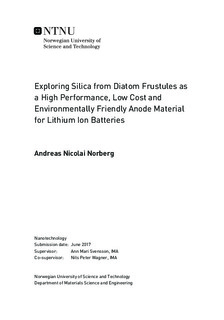| dc.description.abstract | In this work, silica extracted from diatom frustules was explored as a potential high performance, low cost and environmentally friendly anode material for lithium ion batteries. The diatom frustules were washed and calcined, and the resulting silica was characterized by scanning electron microscopy, X-ray diffraction and nitrogen adsorption. Electrodes of milled and unmilled silica were prepared with water soluble Na-alginate, different compositions of conductive additives and carbon coatings. In addition, the effect of the electrolyte additives, fluoroethylene carbonate and vinylene carbonate was explored. Coins cells and three electrode cells were assembled and characterized by galvanostatic cycling and electrochemical impedance spectroscopy. After cycling, post mortem characterization of the electrodes was performed by scanning electron microscopy, energy dispersive X-ray spectroscopy and focused ion beam characterization.
The capacity of the silica anodes was low during regular galvanostatic cycling for all electrode and electrolyte parameters. However, an electrochemical reduction program in combination with milled silica, was found to significantly increase the capacity of the best performing silica anode to an average capacity of 723 mAh/g after 50 cycles. In addition, the anodes exhibited excellent cycling stability and good rate capability up to 1000 mA/g. Differential capacity analysis revealed that the capacity was caused by the conversion of silica to silicon, and subsequent lithiation of silicon. Carbon coating the silica improved the initial capacity. However, no improvements were observed after 50 cycles. In addition, the carbon coating was found to contribute significantly to the capacity of the cell. For wide spread application of silica from diatom frustules to take place, the drawbacks of the electrochemical reduction program and the high first cycle irreversible capacity loss must be addressed. | |

